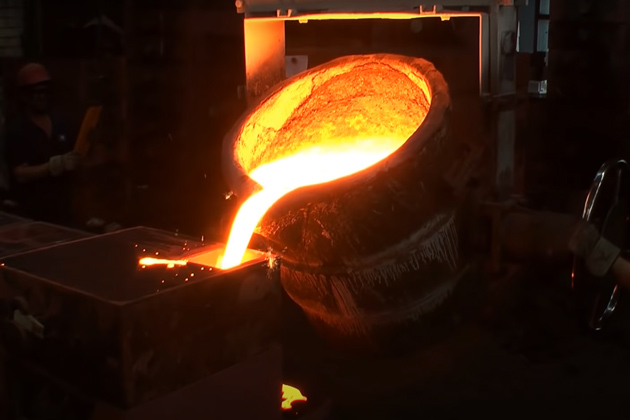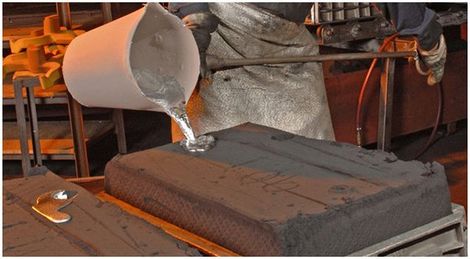Discover the Cutting-edge Methods Used in a Metal Foundry for Superior Casting Outcomes
In today's competitive manufacturing landscape, metal foundries are increasingly taking on ingenious techniques to boost casting outcomes - Aluminum Foundry. Advanced computer simulations enable exact modeling of liquified metal habits, while 3D printing makes it possible for fast production of complicated molds. Furthermore, eco-friendly products and automation streamline operations. These developments promise significant renovations in effectiveness and quality control. The impact of these modern technologies on sustainability and production techniques stays to be completely checked out.
Advanced Computer Simulations in Metal Casting
Advanced computer system simulations have actually changed the metal casting procedure by improving accuracy and effectiveness. These advanced tools allow engineers to develop online models of actors elements, enabling them to forecast the habits and analyze of molten metal throughout the casting stage. By replicating numerous specifications such as temperature, circulation rate, and air conditioning prices, producers can identify possible problems before physical production begins.
This aggressive technique decreases waste and reduces expensive mistakes, eventually leading to enhanced product quality. Furthermore, simulations help with the optimization of mold layouts, ensuring that they meet the particular needs of each task. The assimilation of computational fluid characteristics (CFD) and finite element analysis (FEA) further adds to the precision of these simulations, supplying insights that were formerly unattainable. As a result, progressed computer simulations have become an essential part of contemporary metal foundries, substantially progressing the sector's capacities.
3D Printing for Mold And Mildews and Patterns
3D printing has actually become a groundbreaking method for producing molds and patterns in the metal foundry market. This modern technology allows the quick manufacturing of intricate geometries that traditional manufacturing methods have a hard time to achieve. By utilizing additive manufacturing, foundries can produce elaborate layouts with reduced lead times and product waste. The capacity to produce molds as needed permits higher versatility in layout models, promoting faster prototyping and alterations.
3D printing can make use of a selection of products, consisting of metals and plastics, tailored to specific casting requirements. This versatility boosts the accuracy of mold and mildews, leading to exceptional casting outcomes with boosted surface area finishes. Furthermore, the decrease in the number of parts required simplifies assembly processes, even more enhancing production performance. As foundries continue to adopt 3D printing, they are poised to redefine market standards, leading the way for innovation and improved efficiency in metal spreading operations.
Eco-Friendly Products and Processes
As the metal foundry market faces raising pressure to minimize its ecological footprint, the fostering of green materials and processes has actually come to be important. Shops are now exploring sustainable choices to standard products, such as using recycled steels and bio-based binders. These materials not only lessen waste yet also reduced energy intake during manufacturing.
Additionally, improvements in sand spreading techniques have resulted in using synthetic sands that are less harmful to the setting. Factories are also applying ingenious processes like liquified metal treatment that minimizes discharges and improves the high quality of cast items.
Furthermore, water-based coverings have actually replaced poisonous solvents, advertising a safer workplace (Aluminum Foundry). By integrating these environment-friendly methods, metal foundries can noticeably decrease their eco-friendly effect while keeping top notch casting results. This change not just profits the environment yet additionally straightens with the expanding customer demand for sustainable production solutions
Automation and Robotics in Foundry Workflow
While the metal foundry market welcomes development, the combination of automation and robotics is changing procedures substantially. Automated systems enhance processes such as mold making, metal putting, and casting completing, substantially boosting effectiveness. Robotics assist in the handling of hefty materials, minimizing the threat of office injuries and making certain safer More Help atmospheres.

Better, making use of automated directed lorries (AGVs) maximizes product transport within centers, making certain timely delivery of components to ideal workstations. By carrying out these technologies, foundries can adjust to changing demands with better dexterity, ultimately causing boosted profitability and competitiveness in the marketplace. As automation and robotics continue to advance, they hold the possible to redefine conventional foundry techniques and drive additional developments in casting strategies.
Real-Time Surveillance and Quality Assurance Techniques
The advancements in automation and robotics have paved the means for much more innovative methods to quality control in metal foundries. Real-time tracking systems make use of advanced sensors and information analytics to track crucial parameters throughout the casting process. These systems continually assess variables such as temperature level, pressure, and product make-up, allowing instant discovery of discrepancies from developed criteria.
Quality assurance strategies now integrate maker discovering algorithms that examine historic data to anticipate prospective flaws prior to they take place. This proactive technique decreases waste and boosts overall production efficiency. Additionally, integrated feedback loops allow for rapid modifications, ensuring that each casting meets strict high quality needs.
The execution of electronic doubles-- online replicas of physical assets-- has likewise changed quality control, allowing designers to imitate and enhance processes in real-time. Together, these ingenious methods significantly boost the dependability and high quality of castings, establishing brand-new market requirements in metal foundry operations.
Regularly Asked Questions
What Kinds of Metals Are Commonly Cast in Foundries?
Generally cast metals in foundries i loved this include light weight aluminum, brass, iron, and bronze. Each metal shows one-of-a-kind properties, making them suitable for different applications, such as automobile components, equipment, and creative sculptures, improving their convenience in production.

How much time Does the Casting Refine Typically Take?
The spreading procedure commonly takes a number of hours to days, depending upon factors such as the intricacy of the mold and mildew, sort of metal utilized, and air conditioning requirements. Each stage influences the overall period substantially.
What Safety and security Measures Remain In Area for Foundry Workers?

Exactly how Are Flaws in Castings Identified and Addressed?
Defects in castings are recognized through aesthetic inspections and non-destructive screening approaches. When identified, foundry workers resolve them by refining processes, changing product make-ups, and executing restorative measures to guarantee top quality and compliance with requirements.
What Is the Price Array for Metal Casting Providers?
The cost array for metal casting services commonly varies in between $1 to $10 per extra pound, depending on aspects such as product kind, intricacy of the design, and production quantity, impacting overall prices significantly.
In today's competitive production landscape, metal foundries are progressively taking on cutting-edge techniques to boost spreading results. As the metal foundry industry deals with increasing stress to reduce its ecological impact, the fostering of green products and processes has ended up being crucial. Shops are now exploring sustainable alternatives to traditional materials, such as using bio-based binders and recycled steels. By incorporating these green practices, metal foundries can significantly decrease their eco-friendly effect while preserving top quality spreading results. The innovations in automation and robotics have paved the means for much more sophisticated approaches to high quality assurance in metal foundries.